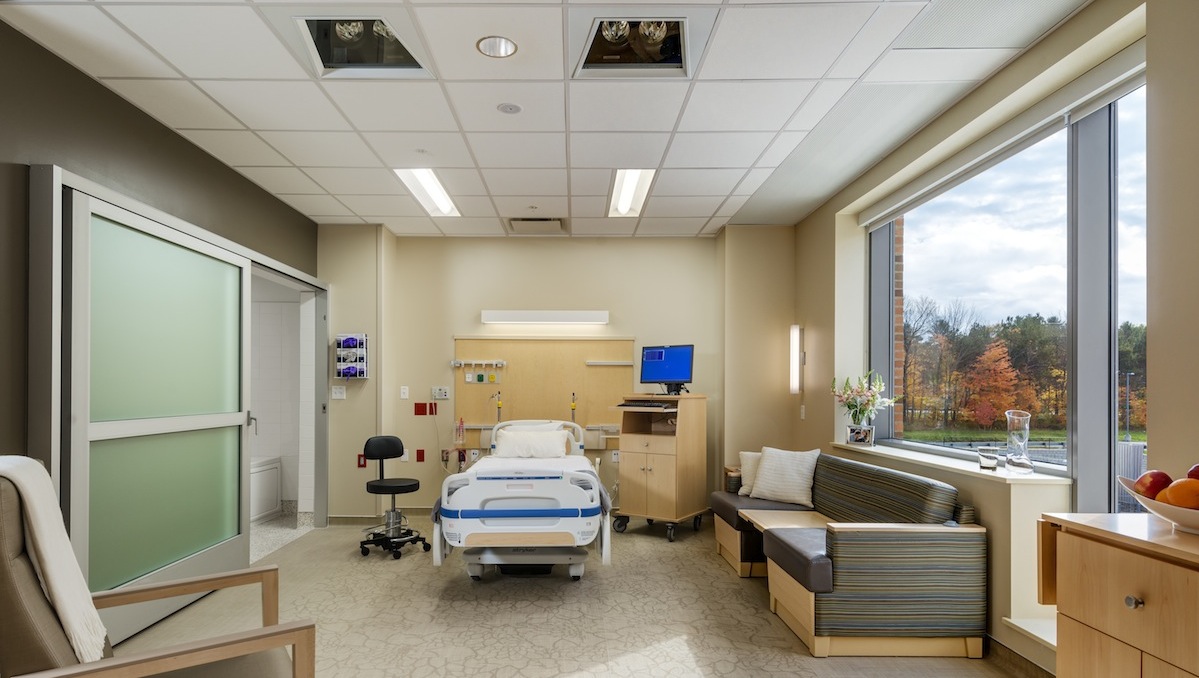Over the past few decades, numerous research studies have concluded that noise in hospitals can have a deleterious effect on patient care and recovery. “The first step in noise reduction in hospitals is awareness about the effect that noise has on patients and providers,” says Paul Barach, MD, Clinical Professor, Wayne State University, Detroit.
Barach cites studies that estimate average hospital noise at 70–80 decibels, or 20–30 db above World Health Organization recommended levels. Older hospitals have even worse acoustics. Barach also suggests that noise in general is an “abstraction” that even newer hospitals find difficult to define and mitigate.
Noise control is even more important now that the Affordable Care Act has mandated that reimbursement for hospital services be based, in part, on patient satisfaction surveys. These surveys have consistently given the lowest scores to hospital environments for sleep disruption. It’s little wonder, then, that hospitals are pursuing more quietude in their plans for new buildings, renovations and expansions, as well as in their personnel training.
“Acoustics is invisible until it’s a problem,” observes James Perry, Chief Technology Officer for the New York-based acoustical and A/V consultant Cerami & Associates. He emphasizes, too, that noise “is about behavior,” and often is generated “by activities [more] than building systems.”
Different rooms, different noises
Noise abatement strategies need to take into account that hospitals have many rooms with different noise characteristics, says Ben Davenny, PE, INCE, LEED AP EDAC, a Senior Acoustical Consultant with Acentech. Patient floors are usually organized around bustling nurses’ stations. MRI rooms are particularly sensitive to vibration through floors and walls. Operating rooms require 20 air exchanges per hour, creating their own unique din.
There are lobbies, waiting rooms, examination and emergency rooms where privacy is paramount. Many larger, regional hospitals have helipads: their chopper noise must be kept from entering the building.
Davenny points out that it is useful to consider the type of noise source. “There’s a false impression that a quieter environment is always a better one,” he says. “The trick is to take a different look at these noise sources and develop more efficient methods in reducing disturbance to patients.”
Medical technology has become a new noise source that has “overwhelmed” the hospital environment, says Joanne Solet, PhD, Assistant Clinical Professor of Medicine at Harvard Medical School. Solet was part of a team of researchers that conducted a three-day study in which the team subjected 12 healthy participants to 14 different sounds to determine which sounds were most likely to disrupt sleep.
The team’s findings, published in the Annals of Internal Medicine (June 2012), found that “electronic sounds” were more arousing than others. “If these noises bothered a dozen healthy people, you can bet they are bothering people who are patients,” says Solet.
Over the din, patients are heard
Noise reduction started showing up on hospitals’ radar screens in 2006, when the Centers for Medicare & Medicaid Services (CMS) implemented an ongoing national survey—known as the Hospital Consumer Assessment of Healthcare Providers and Systems, or HCAHCP—to measure customer satisfaction with hospital care. When the Affordable Care Act became law, it included a requirement that the survey results be used as one measure to calculate payments that CMS made to acute-care hospitals.
“The surveys let consumers weigh in, and with HCAHCP, hospitals can’t bury their issues,” says David Sykes, Chairman of the Acoustics Research Council.
From July 1, 2013 through June 30, 2014, the latest period tracked and posted by Medicare.gov, 62% of patients surveyed said their rooms were “always quiet at night,” with another 29% saying their rooms were “usually quiet.” Those scores were below patient ratings for 30 other criteria of their hospital stay, such as cleanliness and communications.
With one in three hospitals operating in the red, according to the American Hospital Association, patient satisfaction has become a make or break issue. The poorest-performing hospitals have 1% of their total annual reimbursements withheld by CMS; the highest-performing facilities get a 1% bonus. By 2017, those fines and bonuses will increase to 2%.
“Hospitals need to know how much quiet a patient needs to be able to sleep because they’re getting dinged by the government if their performance scores are low,” says Gary Madaras, PhD, Associate AIA, ASA, INCE, an Acoustics Specialist with Rockfon, which makes acoustic ceiling products. Solet adds that the government now bases its acceptance levels for patient readmission to hospitals in part on the facility’s past performance.
Healthcare systems are addressing this problem by getting more stakeholders involved in helping them improve patient satisfaction. HGA Architects and Affinity Health solicited input from former patients, family members, and caregivers during pre-design sessions for Affinity’s 25,000-sf Heart, Lung, and Vascular Center at St. Elizabeth Hospital, in Appleton, Wis. Those sessions included discussions about workflow, corridor circulation patterns, and patient privacy. The team also implemented a post-occupancy evaluation determine whether its evidence-based design principles were being achieved in areas that include noise levels.
For several years now, architects have been turning to the Facilities Guidelines Institute’s guidelines for product and design best practices that can help their clients tone down noise and vibration. “We provide the tools to build the better mousetrap,” says FGI CEO Douglas Erickson, FASHE, CHFM, HFDP, CHC.
Stanford Health Care, Palo Alto, Calif., is building an 824,000-sf, 368-bed hospital that is following many of the noise and vibration reduction guidelines laid out by the FGI, says George Tingwald, MD, AIA, ACHA, Director of Medical Planning, Facilities Design and Construction at Stanford Health.
Hospitals are also trying to get their employees to be more alert to the noise they produce. Bonny Slater, Senior Interior Designer-Health & Wellness in Gensler’s Washington, D.C., office, sees hospitals experimenting with “quiet times,” when corridor lights are dimmed to signal when noise volumes should be lowered.
Reactions to noise are subjective
Not everyone is convinced that design can alter staff behaviors to reduce hospital noise, especially when a lot of hospitals still don’t coordinate when clinical, food service, and cleaning staffs enter a patient’s room, says Kenneth Van Wyk, President of consultant Acoustics by Design. “There are no dashboards in hospitals,” says Sykes. Chris Kay, ACHE, Managing Principal-National Healthcare & Science Buildings Practice at Jacobs, is even less sanguine about behavioral modification, which he calls “the least effective method of reducing hospital noise.”
Patient surveys have certainly given hospitals more insight into where their services and facilities are falling short or excelling. Jean R. Elrick, MD, Senior Vice President of Administration at Massachusetts General Hospital, in Boston, gets patient narratives every Wednesday. She says she can tell which buildings and departments are performing best. Mass General’s 530,000-sf Lunder Building, which opened in 2011, was among a handful of hospital facilities that closely followed FGI’s 2010 revised guidelines. Elrick says Lunder’s patient scores have consistently risen, and Lunder has become the model the hospital would follow when it renovates or expands other buildings on its campus.
The 640,000-sf MaineGeneral Medical Alfond Center for Health, in Augusta, which opened in August 2013, is another replacement hospital that was built to FGI’s noise and vibration guidelines. As a result, its “always quiet at night” score improved to 76.5% over the period December 2013 through July 2014, from 61.5% over the period January through October 2013. The portion of patients who would recommend the hospital jumped to 76.8%, from 65.2%, according to Rick Albert, MaineGeneral’s Director of Plant Operations.
But patient scores don’t tell the whole story, mainly because surveys don’t identify which noises are causing the most distress. Since 2010, Rockfon’s Madaras has tracked patient scores of about 50 new hospitals. He has found that most new faciliies aren’t that much better than older ones. Those findings lead Madaras to believe that reactions to hospital noises can be individual and subjective.
Solet points out that a certain portion of the population is always going to be more sensitive to their surroundings. So, says Tingwell of Stanford Health Care, a hospital’s biggest dilemma, when devising a noise-reduction strategy, might be figuring out how to assuage patients’ perceptions, real or imagined, about noise.
Related Stories
| Oct 13, 2010
Maryland replacement hospital expands care, changes name
The new $120 million Meritus Regional Medical Center in Hagerstown, Md., has 267 beds, 17 operating rooms with high-resolution video screens, a special care level II nursery, and an emergency room with 53 treatment rooms, two trauma rooms, and two cardiac rooms.
| Oct 13, 2010
Cancer hospital plans fifth treatment center
Construction is set to start in December on the new Cancer Treatment Centers of America’s $55 million hospital in Newnan, Ga. The 225,000-sf facility will have 25 universal inpatient beds, two linear accelerator vaults, an HDR/Brachy therapy vault, and a radiology and imaging unit.
| Oct 13, 2010
New health center to focus on education and awareness
Construction is getting pumped up at the new Anschutz Health and Wellness Center at the University of Colorado, Denver. The four-story, 94,000-sf building will focus on healthy lifestyles and disease prevention.
| Oct 13, 2010
Community center under way in NYC seeks LEED Platinum
A curving, 550-foot-long glass arcade dubbed the “Wall of Light” is the standout architectural and sustainable feature of the Battery Park City Community Center, a 60,000-sf complex located in a two-tower residential Lower Manhattan complex. Hanrahan Meyers Architects designed the glass arcade to act as a passive energy system, bringing natural light into all interior spaces.
| Oct 12, 2010
Holton Career and Resource Center, Durham, N.C.
27th Annual Reconstruction Awards—Special Recognition. Early in the current decade, violence within the community of Northeast Central Durham, N.C., escalated to the point where school safety officers at Holton Junior High School feared for their own safety. The school eventually closed and the property sat vacant for five years.
| Sep 13, 2010
Palos Community Hospital plans upgrades, expansion
A laboratory, pharmacy, critical care unit, perioperative services, and 192 new patient beds are part of Palos (Ill.) Community Hospital's 617,500-sf expansion and renovation.
| Sep 13, 2010
China's largest single-phase hospital planned for Shanghai
RTKL's Los Angles office is designing the Shanghai Changzheng New Pudong Hospital, which will be the largest new hospital built in China in a single phase.
| Sep 13, 2010
'A Model for the Entire Industry'
How a university and its Building Team forged a relationship with 'the toughest building authority in the country' to bring a replacement hospital in early and under budget.
| Sep 13, 2010
Data Centers Keeping Energy, Security in Check
Power consumption for data centers doubled from 2000 and 2006, and it is anticipated to double again by 2011, making these mission-critical facilities the nation's largest commercial user of electric power. With major technology companies investing heavily in new data centers, it's no wonder Building Teams see these mission-critical facilities as a golden opportunity, and why they are working hard to keep energy costs at data centers in check.
| Aug 11, 2010
Green Guide for Health Care launches pilot program, looks for participants
In first quarter 2010, the Green Guide for Health Care, in collaboration with Practice Greenhealth, is launching a one-year Green Guide for Health Care Operations Pilot Program for healthcare organizations engaged in any or all aspects of green operations initiatives, based on Green Guide v2.2 Operations section.
















